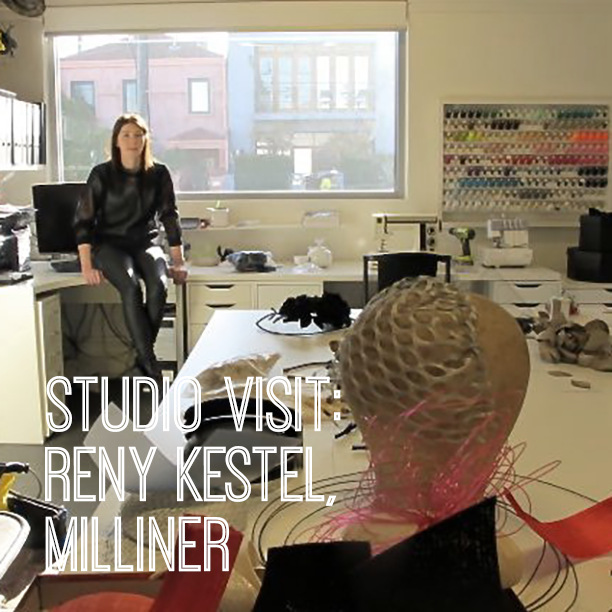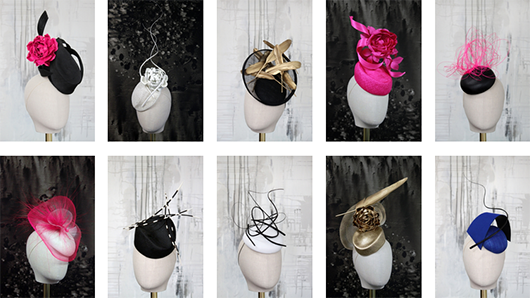Studio visit: Reny Kestel, Milliner
Perth’s fashion scene continues to emerge, and Millinery Designer Reny Kestel is one of the city’s talented designers at the forefront of this movement.
Reny is a young and inventive hatmaker in a competitive industry that got its start in the 1800s. She designs and produces hundreds of headpieces a year for weddings, horse races and fashion weeks that range from edgy wearable art to classic and elegant hats, leather headbands and hand-beaded combs.
Reny, a Perth native, set up her studio and gallery two years ago in the city. Previously she was living in London, England, where she also discovered her interest in millinery.
Some might expect that attracting customers outside of Australia’s most isolated state might be difficult, but Reny’s future-thinking designs and respect for tradition keep her top of mind among a diverse customer base. Women rely on Reny to make custom hats for big racing events of the year like the Melbourne Cup and ongoing regional events throughout the country. She currently designs headpieces for Alana McLean, the face of WA Country Cups.
I visited Reny's Perth studio to ask her about her designs and learn how she stays relevant.
How did you get started in millinery?
I was going to Royal Ascot, and I must have spent hours in this small pokey shop looking at all the trimmings and hat blocks available. This exploring led me to inquire about millinery classes, and from there I have never looked back. I’ve fulfilled my vision by returning to Perth and launching my own label.
It’s kind of an ironic path as I’ve been fascinated with birds from a young age. In fact, I wanted to be an ornithologist when I was 12-years-old. So, it’s nice to be able to work with bird feathers.
 Reny Kestel works on a headpiece in her studio, one of hundreds she produces every year.
Reny Kestel works on a headpiece in her studio, one of hundreds she produces every year.
I have also always had a keen interest in art and design from a young age, and I continued this interest by studying Fashion Design at Central Institute of Technology in Perth. I love the idea of wearable art, and fashion is a great form of self-expression. The 3D shape in art and sculpture, and designing with patterns from flat fabrics has always been exciting.
How have you set up your space to help you be productive?
Being organised is definitely key. I need to have materials that I use frequently, easily accessible and colour coordinated so I can grab them with minimal fuse.
My other essential items are clearly positioned in the right workspace areas, such as millinery wire on hooks with tape measures and wire cutters hanging next to them. I have two large steel rulers fixed to the large central table, so when I need fabric straw materials or Petersham ribbon I can quickly measure the exact amount and be able to note the amount I use.
I always go by the rule that everything has a home. My materials are arranged and labeled so I know with a quick glance what I am looking for. I try to clear the workshop table space every few days or weekly, and put things back in their place after an artistic explosion. I find I can’t get into a creative mode and think clearly without using a clean space.
 Reny and her father created this thread spool holder to make her material easily accessible and keep it organised.
Reny and her father created this thread spool holder to make her material easily accessible and keep it organised.
What's your biggest creative fear and how are you overcoming it?
Not really fearful, but I’d call it…creative pressure – that is balancing my creative time with the general operations of the business, which involves emails, calls, sales, bookwork, administration, public relations and social media.
I also have to ensure that the time I spent creating each piece aligns with the price of the piece. This can create a bit of pressure to get things made within a certain time period.
 A leather headband in progress on Reny's work table.
A leather headband in progress on Reny's work table.
How does living in an isolated state help and/or challenge your business?
Since the whole Internet revolution, I don’t notice how isolated Perth is anymore. Connecting to people, finding inspiration, and material sourcing is not a problem now.
Perth’s population is small, so it does help in terms of networking. We are lucky to have a strong supportive fashion industry in Western Australia, and I think this is because the state is so isolated.
One last question…
At the end of our visit I asked Kestel if she has attracted any North American clients yet, where I anticipate her designs could catch on. “Not yet,” she said, but one thing is certain, Australia is lucky to have a defining homegrown designer like Kestel.
Follow Reny’s designs and shop online at www.renykestel.com.
{Studio images by Kristen Marano}
Kristen Marano is a writer living in Perth, Australia. Kristen helps companies build relationships with their audiences through compelling content programs. She also shares her fashion and lifestyle perspectives with Huffington Post Canada, and produces a weekly newsletter, Creative Women Weekly, featuring stories of creative women from around the world. Follow Kristen on Twitter @kmarano and Instagram @krismarano.

